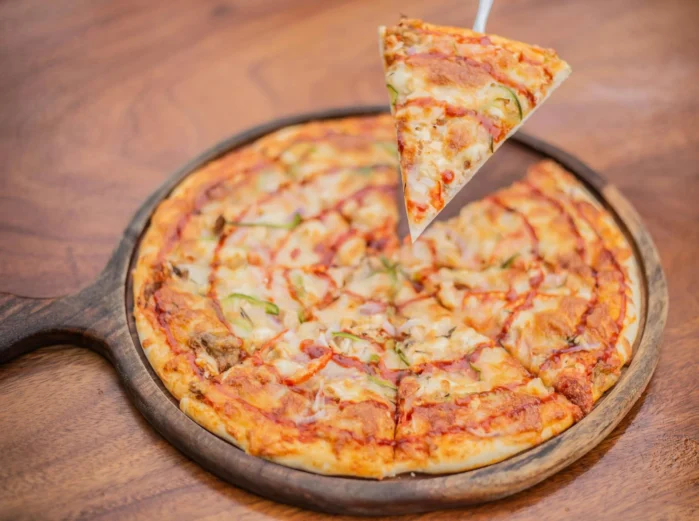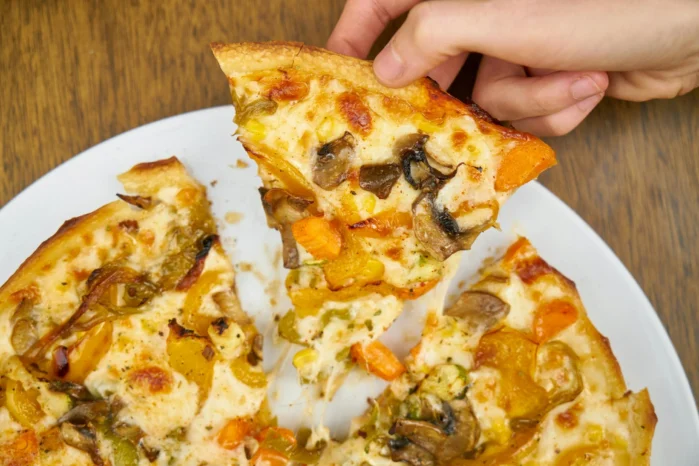
For a delicious homemade pizza, use fresh ingredients and follow simple steps. This recipe ensures a flavorful and satisfying meal.
Homemade pizza is a delightful way to bring family and friends together. It offers the freedom to customize toppings and flavors to suit everyone’s tastes. Fresh dough, tangy tomato sauce, and melty cheese form the foundation of this classic dish.
Whether you prefer a traditional Margherita or a loaded veggie pizza, creating your own pie at home is both fun and rewarding. Plus, you can control the quality of ingredients, ensuring a healthier meal. Follow this easy recipe to make a perfect homemade pizza that will impress your guests and leave everyone craving more. Lets learn every steps in detail of a very tasty, healthy Homemade Pizza Recipe.
Ingredients For Dough for Homemade Pizza Recipe
Making homemade pizza is a delightful experience. The first step to a perfect pizza is creating the dough. This section will guide you through the essential ingredients needed for an amazing pizza dough. Master these ingredients and your pizza will be a hit every time!
Flour Choices
The type of flour you use can dramatically affect your pizza dough. Here are some popular choices:
- All-Purpose Flour: This is a versatile option and works well for most recipes. It creates a chewy crust.
- Bread Flour: This flour has a higher protein content, which results in a crispier crust. It’s a favorite among pizza enthusiasts.
- 00 Flour: This is the gold standard for pizza dough, especially for Neapolitan-style pizza. It has a fine texture and creates a soft, chewy crust.
Consider these points when selecting your flour:
- Check the protein content on the packaging. Higher protein means more gluten development.
- If experimenting, blend different flours to achieve your desired crust texture.
Yeast Types
Yeast is the magic ingredient that makes your dough rise. There are different types of yeast you can use:
- Active Dry Yeast: This is the most common type. It needs to be dissolved in warm water before use.
- Instant Yeast: Also known as rapid-rise yeast, it can be mixed directly with the dry ingredients. It works faster than active dry yeast.
- Fresh Yeast: This is less common but beloved by professional bakers. It has a short shelf life and needs to be dissolved in water.
Here’s a quick comparison table:
| Yeast Type | Preparation | Rise Time |
|---|---|---|
| Active Dry Yeast | Dissolve in warm water | Medium |
| Instant Yeast | Mix with dry ingredients | Fast |
| Fresh Yeast | Dissolve in water | Medium |
Water Temperature
Water temperature is crucial for activating yeast. It should be warm, but not too hot. Follow these guidelines:
- Active Dry Yeast: Water should be between 105°F and 110°F. Use a thermometer for accuracy.
- Instant Yeast: It can tolerate a wider range, but 120°F to 130°F works best.
- Fresh Yeast: Use water around 95°F. This temperature is ideal for keeping the yeast alive and active.
If the water is too hot, it will kill the yeast, and your dough won’t rise. If too cold, the yeast won’t activate properly. Always ensure the water is at the right temperature for the best results.
Explore here The Best Healthy Chicken Salad Recipe
Salt Importance
Salt is more than just a flavor enhancer in pizza dough. It plays several critical roles:
- Flavor: Salt brings out the natural flavors in the dough, making your pizza taste better.
- Yeast Control: It regulates the activity of the yeast, ensuring a steady rise and preventing over-fermentation.
- Gluten Strength: Salt strengthens the gluten structure, giving the dough elasticity and a better texture.
Be cautious with the amount of salt you use. Too much can slow down or even halt the yeast activity. Typically, 1-2 teaspoons of salt per 500 grams of flour is ideal.
In summary, each ingredient in your pizza dough recipe has a unique role. Understanding these roles will help you make the best homemade pizza dough ever!

Preparing The Dough
Making homemade pizza is both fun and delicious. The secret to a perfect pizza lies in preparing the dough correctly. This guide will walk you through each step, ensuring your dough is just right for a mouth-watering pizza.
Mixing Ingredients
Start by gathering your ingredients. You’ll need:
- 4 cups of all-purpose flour
- 1 and 1/2 cups of warm water
- 2 teaspoons of salt
- 1 teaspoon of sugar
- 2 teaspoons of olive oil
- 1 packet of active dry yeast
First, dissolve the yeast and sugar in warm water. Let it sit for about 5 minutes until it becomes frothy. In a large bowl, mix the flour and salt. Make a well in the center and pour in the yeast mixture and olive oil. Stir until the mixture forms a soft dough.
Here’s a quick overview:
| Ingredient | Amount |
|---|---|
| All-purpose flour | 4 cups |
| Warm water | 1 and 1/2 cups |
| Salt | 2 teaspoons |
| Sugar | 1 teaspoon |
| Olive oil | 2 teaspoons |
| Active dry yeast | 1 packet |
Kneading Techniques
Kneading is crucial for developing gluten. It makes the dough stretchy and chewy. Begin by lightly flouring a clean surface. Transfer your dough to this surface.
Use the heel of your hand to push the dough away from you. Fold it back toward you, and give it a quarter turn. Repeat this process for about 10 minutes. The dough should become smooth and elastic. Here are some key points to remember:
- Keep your surface lightly floured to prevent sticking.
- If the dough is too sticky, add a bit more flour.
- Don’t over-knead; it can make the dough tough.
Rising Time
Once kneaded, place the dough in a bowl lightly coated with olive oil. Cover it with a damp cloth or plastic wrap. Let it rise in a warm place. This usually takes about 1 to 2 hours.
The dough should double in size. Check by pressing a finger into the dough. If the indentation remains, it’s ready. If it springs back, let it rise a bit longer.
Optimal conditions for rising:
| Temperature | Time |
|---|---|
| Room Temperature (70-75°F) | 1 to 2 hours |
| Warmer (80-85°F) | 1 hour |
Dough Storage
If you don’t plan to use the dough right away, you can store it. After the first rise, punch down the dough to release air. Divide it into portions if needed.
Wrap each portion tightly in plastic wrap. You can store it in the refrigerator for up to 3 days or in the freezer for up to 3 months. When ready to use, let refrigerated dough sit at room temperature for 30 minutes. For frozen dough, thaw it in the refrigerator overnight, then let it come to room temperature. 
Storage tips:
- Always use airtight containers to prevent drying out.
- Label the storage date.
- Check for any signs of spoilage before use.
Pizza Sauce Basics
Making your own pizza at home can be a delightful experience, and the secret to a perfect pizza lies in its sauce. Understanding the basics of pizza sauce can elevate your homemade pizza to restaurant-quality. From selecting the right tomatoes to choosing the best herbs, each step is crucial. Let’s delve into the essentials of pizza sauce.
Tomato Varieties
Choosing the right tomatoes is the first step in creating an excellent pizza sauce. San Marzano tomatoes are highly recommended for their sweet flavor and low acidity. These tomatoes are often considered the gold standard for pizza sauce.
Here are some common tomato varieties and their characteristics:
| Tomato Variety | Characteristics |
|---|---|
| San Marzano | Sweet, low acidity, rich flavor |
| Roma | Thick flesh, less water, ideal for sauces |
| Cherry | Sweet, juicy, adds a fresh touch |
San Marzano tomatoes are often canned, making them convenient and accessible. Roma tomatoes are another great choice, known for their thick flesh and fewer seeds. Cherry tomatoes can add a fresh, sweet twist to your sauce.
Herb Selection
Herbs play a vital role in enhancing the flavor of your pizza sauce. Basil is a classic choice, providing a sweet and slightly peppery taste. Oregano is another essential herb, offering a robust and earthy flavor.
Consider these herbs for your pizza sauce:
- Basil: Sweet, peppery, aromatic
- Oregano: Earthy, robust, slightly bitter
- Thyme: Pungent, slightly minty
- Rosemary: Pine-like, woody
Using fresh herbs can make a significant difference. Fresh basil leaves can be added at the end of cooking for a vibrant flavor. Dried oregano can be used during cooking to infuse the sauce with its earthy taste.
Cooking Techniques
The way you cook your pizza sauce can significantly impact its flavor and texture. Sautéing garlic and onions in olive oil before adding tomatoes can build a rich base. Simmering the sauce allows the flavors to meld together beautifully.
Follow these steps for a perfect sauce:
- Heat olive oil in a pan.
- Add minced garlic and diced onions, sauté until translucent.
- Add crushed tomatoes and bring to a simmer.
- Season with salt, pepper, and your chosen herbs.
- Let the sauce simmer for at least 30 minutes, stirring occasionally.
Cooking the sauce slowly helps to concentrate the flavors. Avoid boiling, as it can make the sauce too thick or too acidic.
Also Read: Healthy Creamy Mushroom Soup Recipe For Dinner
Flavor Enhancements
To make your pizza sauce stand out, consider adding some flavor enhancements. A pinch of sugar can balance the acidity of the tomatoes. Red pepper flakes can add a subtle heat to the sauce.

Here are some additional flavor boosters:
- Parmesan Cheese: Adds a savory, umami flavor
- Anchovy Paste: Provides depth and a hint of saltiness
- Balsamic Vinegar: Adds sweetness and complexity
- Red Wine: Enhances richness and depth
Parmesan cheese can be stirred into the sauce for a creamy texture. A splash of red wine can deepen the flavor profile of your sauce. Experimenting with these enhancements can help you create a unique and delicious pizza sauce.
Choosing Toppings
Making homemade pizza is a delightful experience. One of the most fun parts is choosing toppings. You can customize your pizza to suit any taste. From classic options to unique combinations, the choices are endless. Let’s explore how to pick the perfect toppings for your homemade pizza.
Read More: Simple Spaghetti Recipe ( Done In 15 Minutes)
Cheese Options
Cheese is the heart of any pizza. Choosing the right cheese can make your pizza delicious. Here are some cheese options:
- Mozzarella: This is the most popular cheese for pizza. It melts well and has a mild flavor.
- Cheddar: Cheddar adds a sharp taste. It pairs well with other cheeses.
- Parmesan: Parmesan is often used as a topping. It adds a salty and nutty flavor.
- Gouda: Gouda has a smoky flavor. It melts beautifully.
- Goat Cheese: Goat cheese is tangy and creamy. It works well with vegetables.
Mixing different cheeses can create a rich and complex flavor. Try combining mozzarella with a bit of cheddar or parmesan. Experiment to find your favorite blend.
Meat Varieties
Meat toppings add a hearty and savory taste to your pizza. Here are some popular meat choices:
- Pepperoni: A classic choice. It’s spicy and crispy.
- Sausage: Sausage can be sweet or spicy. It adds a robust flavor.
- Bacon: Bacon bits bring a smoky and salty taste.
- Chicken: Grilled chicken pieces are healthy and delicious.
- Ham: Ham adds a sweet and savory flavor. It pairs well with pineapple.
For a meat lover’s pizza, you can combine different meats. Try pepperoni and sausage together. Add some bacon for extra crunch. Balance the flavors with the right amount of meat.
Vegetable Choices
Vegetables bring color and freshness to your pizza. They add a variety of flavors and textures. Here are some great vegetable options:
- Bell Peppers: They add a sweet and crunchy texture.
- Onions: Onions provide a sharp and sweet taste.
- Mushrooms: Mushrooms add an earthy and savory flavor.
- Olives: Olives bring a salty and tangy taste.
- Spinach: Fresh spinach adds a mild and leafy flavor.
Mix different vegetables for a vibrant and healthy pizza. You can create a veggie lover’s pizza with a mix of bell peppers, onions, mushrooms, and olives. Add spinach for an extra touch of green.

Unique Additions
Unique toppings can make your pizza stand out. Here are some creative ideas:
- Pineapple: Adds a sweet and tangy flavor. Perfect with ham.
- Artichoke Hearts: They add a tender and slightly nutty taste.
- Sun-dried Tomatoes: These tomatoes add a sweet and tangy taste.
- Figs: Figs bring a sweet and chewy texture.
- Truffle Oil: A drizzle of truffle oil adds a rich and earthy flavor.
Experiment with these unique additions to create a gourmet pizza. Combine sun-dried tomatoes with artichoke hearts. Add a drizzle of truffle oil for a fancy touch. Let your creativity shine with these special toppings.
Assembling The Pizza
Homemade pizza is a fun and delicious way to enjoy a meal with family and friends. Assembling the pizza is a crucial step where you bring together all the prepared ingredients to create a mouth-watering masterpiece. Let’s dive into the process of putting it all together.
Rolling Out Dough
Start with your homemade or store-bought dough. Make sure it’s at room temperature for easy handling. Lightly flour your work surface to prevent sticking. Use a rolling pin to flatten the dough to your desired thickness.
Steps to roll out dough:
- Place the dough on the floured surface.
- Press down with your palms to flatten it slightly.
- Roll the dough from the center outwards.
- Rotate the dough 90 degrees and repeat until you have a circle.
Pro tip: If you prefer a thicker crust, roll it out less. For a thin crust, roll it out more. Transfer the dough to a pizza stone or baking sheet before adding toppings.
Spreading Sauce
Next, spread your favorite pizza sauce evenly over the dough. Use a spoon or ladle for this task. Leave a small border around the edge for the crust.
Types of sauces:
- Tomato-based sauce
- Pesto sauce
- Alfredo sauce
Start with a small amount of sauce and add more if needed. Too much sauce can make the pizza soggy. Spread the sauce in a circular motion, starting from the center and working your way out.
Layering Toppings
This is where you can get creative. Choose your favorite toppings and layer them on the sauce. Start with the basics like cheese and then add vegetables, meats, and herbs.
Popular topping combinations:
| Classic | Veggie Delight | Meat Lover’s |
|---|---|---|
| Pepperoni, mozzarella | Bell peppers, onions, olives | Sausage, bacon, ham |
| Mushrooms, olives | Mushrooms, spinach | Pepperoni, mozzarella |
Distribute toppings evenly to ensure every bite is flavorful. Remember, balance is key.
Final Touches
Before baking, add any final touches. Drizzle olive oil over the top for extra flavor. Sprinkle some herbs like basil or oregano. If you like a bit of heat, add a pinch of red pepper flakes.
Final touch ideas:
- Grated Parmesan cheese
- Fresh basil leaves
- Crushed garlic
Preheat your oven to 475°F (245°C). Bake the pizza for 10-15 minutes or until the crust is golden and the cheese is bubbly. Let it cool for a few minutes before slicing. Enjoy your homemade pizza!
Baking Techniques
Making homemade pizza is an art. Perfect baking techniques can make your pizza delicious and crispy. Let’s dive into the essential baking techniques to make your pizza perfect every time.
Oven Preheating
Preheating the oven is crucial for a perfect pizza. Always preheat your oven to ensure even cooking.
Steps to Preheat Your Oven:
- Turn on your oven 30 minutes before baking.
- Set the temperature to the required level.
- Wait until the oven reaches the set temperature.
Preheating ensures the pizza cooks evenly. It also helps achieve a crispy crust. A properly preheated oven distributes heat evenly. This prevents undercooked or overcooked spots.
Tip: Use an oven thermometer to check the actual temperature. Oven dials can sometimes be inaccurate.
Baking Surfaces
The baking surface affects the pizza’s texture and taste. Choose the right surface for the best results.
Common Baking Surfaces:
| Surface | Benefits |
|---|---|
| Pizza Stone | Even heat distribution, crispy crust |
| Baking Sheet | Convenient, easy to use |
| Cast Iron Pan | Retains heat well, excellent for deep-dish pizza |
Tip: Preheat your pizza stone or cast iron pan in the oven. This helps in achieving a crispy crust.
Temperature Settings
Setting the right temperature is key. The temperature affects the baking time and the pizza’s texture.
Recommended Temperatures:
- Thin Crust: 500°F (260°C)
- Thick Crust: 425°F (220°C)
- Stuffed Crust: 375°F (190°C)
Higher temperatures cook the pizza faster. This results in a crispy crust. Lower temperatures cook the pizza slower. This makes the crust softer.
Tip: Experiment with different temperatures. Find what works best for your taste and oven.
Baking Time
Baking time depends on the crust thickness and the oven temperature. Monitor your pizza to avoid over or undercooking.
General Baking Times:
- Thin Crust: 8-10 minutes at 500°F (260°C)
- Thick Crust: 15-20 minutes at 425°F (220°C)
- Stuffed Crust: 20-25 minutes at 375°F (190°C)
Check the pizza halfway through the baking time. Rotate it if necessary for even cooking. Look for a golden-brown crust and melted cheese.
Tip: Use a pizza peel to rotate your pizza. This helps in achieving even cooking on all sides.
Serving Suggestions
Making homemade pizza is always a fun and delicious experience. But serving it the right way can elevate your pizza night to another level. With the perfect cutting styles, pairing drinks, accompaniments, and presentation tips, you can make your pizza night unforgettable. Let’s dive into some amazing serving suggestions for your homemade pizza.
Cutting Styles
The way you cut your pizza can make a big difference in how it’s enjoyed. Here are some popular cutting styles:
- Traditional Triangle Cuts: This is the most common style. It’s simple and perfect for any occasion. Cut the pizza into even triangle slices starting from the center.
- Square or Rectangular Cuts: Ideal for larger crowds. This style ensures everyone gets a piece. It’s particularly good for party settings. Cut the pizza into a grid pattern.
- Strip Cuts: Great for kids or as appetizers. Cut the pizza into long strips. It’s easy to handle and dip into sauces.
Each style offers a unique way to enjoy your pizza. Choose the one that best suits your event or personal preference.
Pairing Drinks
A perfect drink pairing can complement your pizza flavors. Here are some drink suggestions:
- Red Wine: A classic choice. It pairs well with almost any type of pizza, especially those with rich tomato sauces and savory meats.
- Beer: Light beers for veggie pizzas, IPAs for spicy ones, and stouts for meaty toppings. Beer’s carbonation cleanses the palate.
- Soda: A favorite for kids and casual settings. Cola and lemon-lime sodas are refreshing and complement the cheesy goodness.
- Homemade Lemonade: Perfect for a summer pizza party. It’s refreshing and adds a sweet-tart balance.
Choosing the right drink enhances the overall dining experience. Experiment with different pairings to find your favorite.
Accompaniments
No pizza night is complete without some tasty accompaniments. Here are some must-try options:
- Garlic Bread: A classic side. Warm, buttery, and perfect for dipping in marinara sauce.
- Salads: Fresh salads balance the rich pizza flavors. Try a simple Caesar salad or a mixed greens salad with a light vinaigrette.
- Wings: Spicy or savory wings are a great addition. They add a different protein and flavor profile.
- Stuffed Mushrooms: An elegant side dish. Fill them with cheese, herbs, and breadcrumbs for a tasty bite.
Mix and match these accompaniments for a varied and satisfying meal.
Presentation Tips
How you present your pizza can make it even more appetizing. Here are some tips:
- Use a Wooden Pizza Board: It adds a rustic touch and makes slicing easier.
- Garnish with Fresh Herbs: Sprinkle basil, oregano, or parsley on top for a burst of color and flavor.
- Serve with Dipping Sauces: Offer a variety of sauces like marinara, ranch, or garlic butter. It adds fun and flavor to each bite.
- Arrange Accompaniments Neatly: Place sides around the pizza in an organized manner. It looks inviting and appetizing.
Presentation matters. A well-presented pizza is not only delicious but also visually appealing.
Credit: foodfolksandfun.net
Storing Leftovers
Enjoying a homemade pizza is a delight, but what about those delicious leftovers? Properly storing leftover pizza ensures it stays fresh and tasty for another meal. Let’s dive into the best practices for storing your homemade pizza leftovers.
Refrigeration Tips
Refrigerating your leftover pizza is simple and effective. Follow these steps to keep it fresh:
- Allow to cool: Let the pizza cool to room temperature before refrigerating.
- Use airtight containers: Place slices in airtight containers or wrap them in plastic wrap.
- Layer with parchment paper: If stacking slices, place parchment paper between layers to prevent sticking.
- Store in the fridge: Keep the container in the refrigerator, maintaining a temperature below 40°F (4°C).
Here’s a table summarizing the refrigeration tips:
| Step | Action |
|---|---|
| 1 | Allow pizza to cool |
| 2 | Use airtight containers |
| 3 | Layer with parchment paper |
| 4 | Store in the fridge |
Freezing Methods
If you want to store pizza for a longer period, freezing is the way to go. Follow these steps:
- Cool the pizza: Let the pizza cool completely before freezing.
- Wrap slices individually: Wrap each slice tightly with plastic wrap or aluminum foil.
- Use freezer bags: Place wrapped slices in a freezer bag, removing as much air as possible.
- Label the bags: Write the date on the freezer bag for tracking.
- Freeze: Store the bags in the freezer, ensuring they lay flat.
Freezing pizza helps preserve its flavor and texture. Remember to consume within two months for the best taste.
Reheating Techniques
Reheating pizza properly ensures it tastes as good as new. Here are the best methods:
- Oven: Preheat your oven to 375°F (190°C). Place pizza on a baking sheet and heat for 10 minutes.
- Skillet: Heat a skillet over medium heat. Place the pizza slice in the skillet and cover. Heat for 5-7 minutes until the crust is crispy.
- Microwave: Place a cup of water in the microwave along with the pizza slice. Heat on high for 1-2 minutes. The water helps keep the crust from getting too soggy.
Each method has its pros and cons, so choose the one that suits your needs best.
Shelf Life
Understanding the shelf life of your leftover pizza is crucial for safety and taste:
- Refrigerated pizza: Can last 3-4 days in the fridge.
- Frozen pizza: Maintains quality for up to 2 months in the freezer.
To ensure the best taste and safety, always check for signs of spoilage before consuming. Look for changes in color, texture, and smell. If in doubt, it’s best to discard the pizza.
Frequently Asked Questions
What Ingredients Do I Need For Homemade Pizza?
For homemade pizza, you’ll need flour, yeast, water, olive oil, salt, sugar, tomato sauce, mozzarella cheese, and your favorite toppings.
How Long To Bake Homemade Pizza?
Bake homemade pizza at 475°F (245°C) for 10-15 minutes. Check for a golden crust and melted cheese.
Can I Use Whole Wheat Flour For Pizza Dough?
Yes, you can use whole wheat flour for a healthier pizza dough. It adds a nutty flavor and more fiber.
How Do I Make Pizza Dough Rise Faster?
To make pizza dough rise faster, place it in a warm, draft-free area. You can also use a proofing oven setting.
Conclusion
Creating your own pizza at home is both fun and rewarding. Enjoy the fresh ingredients and customize your toppings. This homemade pizza recipe ensures a delicious and unique meal. Share your homemade pizza experience with family and friends. You’ll never look at store-bought pizza the same way again!









